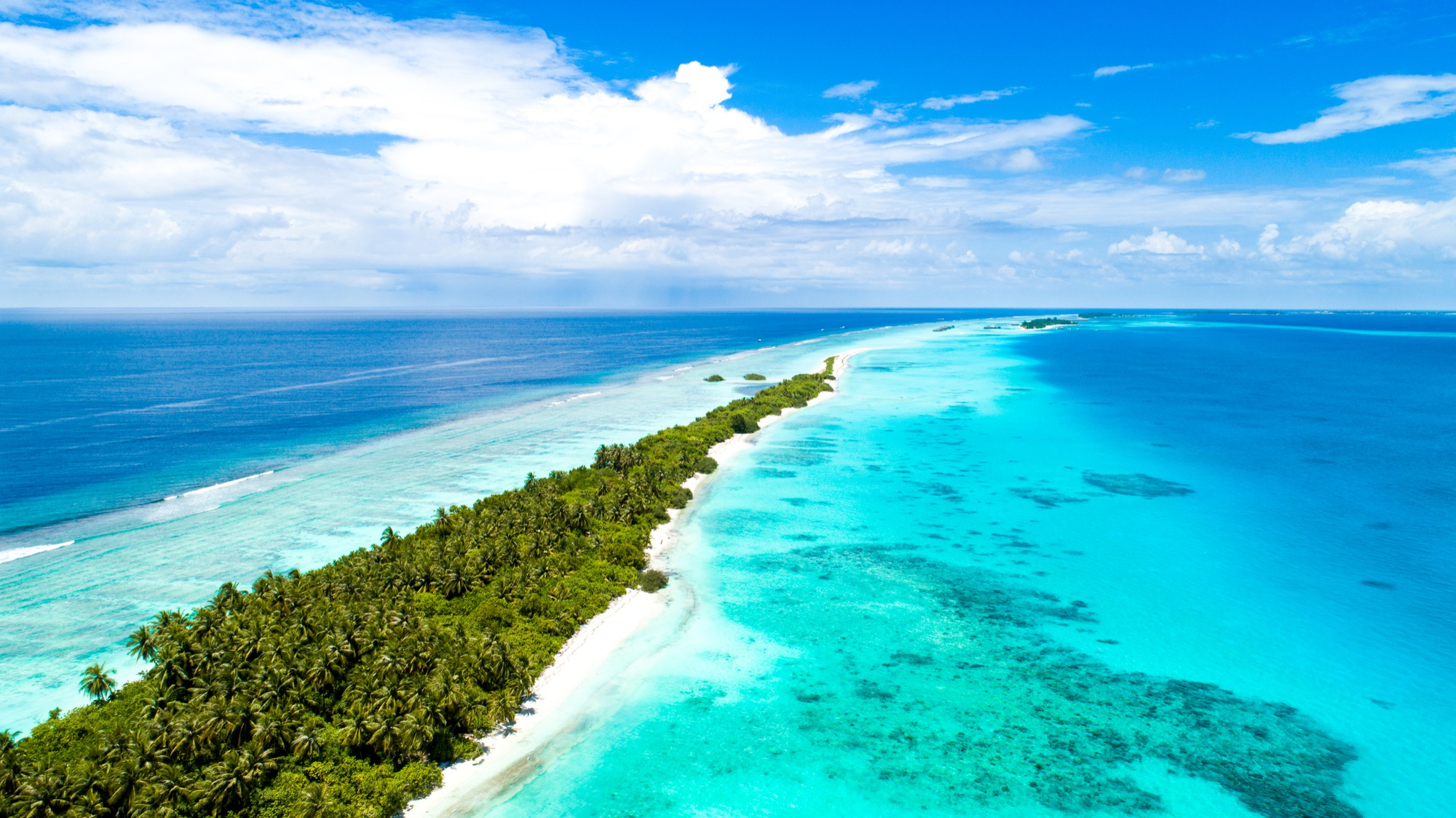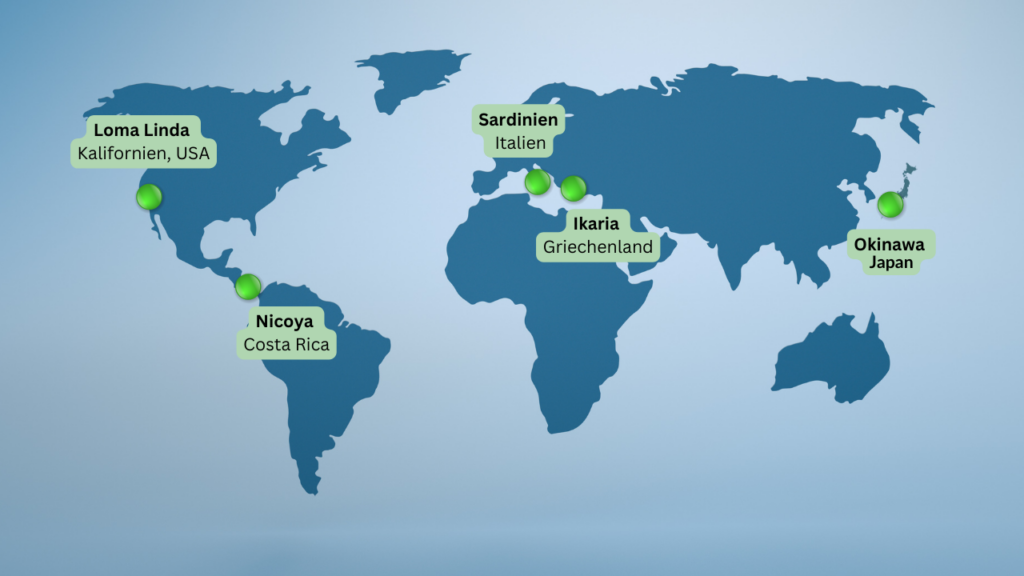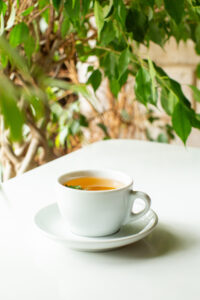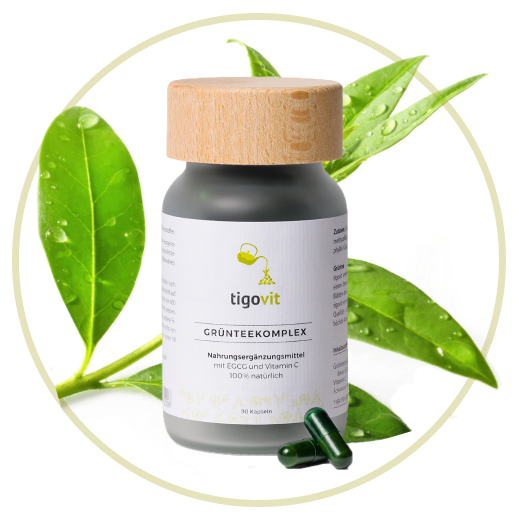
Autorin Nina Ebert, Biologin
Blue Zones (dt. “Blaue Zonen”) sind bestimmte Regionen auf der Erde, die für ihre hohe Anzahl an Hundertjährigen und die außergewöhnliche Langlebigkeit ihrer Bewohner berühmt sind. Diese einzigartigen Gemeinschaften bieten faszinierend einfache Einblicke in Lebensstile und Gewohnheiten, die zu Gesundheit und einem langen Leben beitragen können.
Wo gibt es Blue Zones?
Auf der Erde wurden fünf Blue Zones deklariert:
- Okinawa (Japan): Bekannt als „die Insel der Hundertjährigen“, ist Okinawa berühmt für seine große Anzahl an langlebigen Bewohnern. Die Okinawa-Diät umfasst unter anderem Süßkartoffeln, Sojaprodukte, kaum Zucker sowie viel Grüntee und die Maxime “Hara hachi bu” – aufhören zu essen, wenn ein Sättigungsgrad von 80% erreicht ist.
- Ikaria (Griechenland): Diese abgelegene Insel im Ägäischen Meer ist bekannt für ihre entspannte Lebensweise und niedrige Raten an chronischen Krankheiten. Die Ikaria-Diät basiert auf mediterranen Prinzipien mit Betonung von Gemüse, Olivenöl, Fisch, Kräutern und lokalem Honig. Mittagsschlaf, bekannt als „Siesta“, ist kulturell verankert und unterstützt die Regeneration.
- Sardinien (Italien): Besonders die Bergregion Barbagia (Ogliastra) auf Sardinien zeichnet sich durch eine hohe Konzentration an Hundertjährigen aus. Die sardische Ernährung basiert auf lokal angebautem Gemüse, Hülsenfrüchten, Olivenöl und Ziegenmilchprodukten. Die lokale Weintraubensorte Cannonau verfügt über einen hohen Polyphenolgehalt. Dank Berglandschaft wird eine hohe tägliche Aktivität praktiziert und es existieren starke familiäre, soziale Bindungen.
- Loma Linda (Kalifornien, USA): In dieser Gemeinschaft, in der viele Siebenten-Tags-Adventisten leben, ist eine überdurchschnittlich hohe Lebenserwartung zu beobachten. Die Adventisten verkörpern eine ganzheitliche Lebensführung, die Ernährung, Bewegung, soziale Interaktion und spirituelles Wohlbefinden integriert. Die pflanzliche Ernährung umfasst Vollkornprodukte, Hülsenfrüchte, Nüsse und Früchte; Tabak und Alkohol werden gemieden. Die regelmäßige Teilnahme an Gottesdiensten stärkt Zusammenhalt und psychische Gesundheit.
- Nicoya (Costa Rica): Die Halbinsel Nicoya ist für ihre robusten Senioren bekannt, die ein aktives Leben führen. Die Nicoya-Diät basiert auf traditioneller, lokaler zentralamerikanischer Kost, umfasst Bohnen, Mais, lokale Früchte und Gemüse. Das Trinken von hartem Wasser, das reich an Mineralien ist, kann dazu beitragen. Die Bewohner pflegen starke soziale Bindungen und beteiligen sich an Gemeinschaftsaktivitäten. Die Lebensweise ist geprägt von täglicher körperlicher Arbeit unter freiem Himmel, wie Landwirtschaft und Viehzucht. Stress ist niedrig, und die Menschen schätzen ihre Lebensfreude.

Die 5 Säulen der Blue Zones
Die „Blue Zones“ zeichnen sich durch gemeinsame Merkmale aus, die als „Säulen“ der Langlebigkeit und Gesundheit betrachtet werden. Diese Säulen wurden vom Journalisten und Forscher Dan Buettner identifiziert und umfassen:
- Ernährung: Eine überwiegend regionale, pflanzliche Ernährung mit Schwerpunkt auf Gemüse, Früchten, Hülsenfrüchten, Nüssen und Vollkornprodukten. Der Konsum von Fleisch, insbesondere rotem Fleisch, ist in den Blue Zones oft begrenzt, während Fisch und andere Meeresfrüchte häufiger verzehrt werden. Die Catechine und Bitterstoffe im grünen Tee sind beispielsweise ein wichtiger Aspekt der Insel-Ernährungskultur von Okinawa.
- Bewegung: Natürliche Bewegung im Alltag ist ein gemeinsames Merkmal. Die Menschen in den Blue Zones integrieren regelmäßige körperliche Aktivität in ihre täglichen Aufgaben, sei es durch Gartenarbeit, Spaziergänge oder andere traditionelle Aktivitäten. Viele Landschaften liegen auf Inseln oder in den Bergen, wo besonders reine Luft herrscht.
- Soziale Integration: Starke soziale Bindungen und eine enge Gemeinschaft sind charakteristisch für die Blue Zones. Gemeinschaftliche Aktivitäten, familiäre Unterstützung und ein Gefühl der Zugehörigkeit tragen zur psychischen Gesundheit und Langlebigkeit bei.
- Stressmanagement: Die Menschen in den Blue Zones haben oft Strategien zur Stressbewältigung, sei es durch regelmäßige Pausen, Meditation, Gebet, gelebte Spiritualität und andere entspannende Aktivitäten. Ein niedriges Stressniveau ist ein Schlüssel zum langen Leben.
- Mäßiger Kalorienverbrauch: Eine häufige Praxis in den Blue Zones ist das Prinzip der moderaten Kalorienaufnahme, wie es beispielsweise durch „Hara Hachi Bu“ in Okinawa ausgedrückt wird. Dies kann dazu beitragen, die Belastung des Körpers zu reduzieren.
Diese Säulen bilden die Grundlage für die Lebensweise in den Blue Zones und werden oft als Leitprinzipien für ein gesundes und langes Leben betrachtet.
Die Rolle des Grünen Tees in Okinawa
In Okinawa, einer der berühmten Blue Zones, ist grüner Tee ein fester Bestandteil des täglichen Lebens. Die Bewohner von Okinawa genießen den Teekonsum, wobei der grüne Tee besonders beliebt ist. Er wird nicht nur wegen seines erfrischenden Geschmacks geschätzt, sondern auch als ein Getränk, das eng mit Gemeinschaft und traditionellen Zeremonien verbunden ist.
 Grüner Tee in der Kultur von Okinawa
Grüner Tee in der Kultur von Okinawa
Der Konsum von grünem Tee in Okinawa ist tief in der lokalen Kultur verwurzelt. Er wird oft bei gesellschaftlichen Zusammenkünften getrunken und spielt eine zentrale Rolle in den täglichen Ritualen der Einwohner. In Okinawa wird grüner Tee traditionell in kleinen Tassen serviert, wobei das Teetrinken eine Zeit der Entspannung und der Gemeinschaft ist.
Symbol für Gemeinschaft und Tradition
In Okinawa symbolisiert grüner Tee mehr als nur ein Getränk; er ist ein Symbol für Gemeinschaft und eine Brücke zwischen den Generationen. Alte Teebräuche und -rituale werden von Generation zu Generation weitergegeben, wobei jeder Schluck Tee die reiche Geschichte und Kultur der Insel widerspiegelt.
Okinawa-Diät
Der Grund für die Langlebigkeit der Inselbewohner liegt unter anderem einer Ernährung zugrunde, die sich vom Rest Japans sowie der Welt unterscheidet. Anstelle von Reis, Pasta und Getreide steht die Süßkartoffel im Zentrum der Kohlenhydrate. Zudem ist die Okinawa-Ernährung reich an Blattgemüse, Algen, Kombu, Sojaprodukten wie Miso und Tofu mit gelegentlichem Fleisch- und Fischkonsum. Die Okinawa-Diät enthält nur 30% des Zucker- und 15% des Getreideanteils im Vergleich zum Rest Japans.
Ein weiterer wichtiger Aspekt der okinawischen Ernährungskultur ist der Leitsatz „Hara Hachi Bu“ sowie der Konsum von grünem Tee.
Hara Hachi Bu: Der Begriff „Hara Hachi Bu“ stammt aus der okinawanischen Sprache und bedeutet wörtlich „Essen bis man zu 80 Prozent satt ist“. Dieses Prinzip der bewussten Ernährung lehrt die Menschen, ihre Mahlzeiten zu beenden, bevor sie sich vollständig satt fühlen. Dieser Ansatz kann dazu beitragen, Überernährung zu vermeiden, den Kalorienverbrauch zu regulieren und möglicherweise zu einer längeren Lebenserwartung beizutragen.
Grüner Tee: Der regelmäßige Konsum von grünem Tee ist ein weiteres Schlüsselelement der Okinawa-Diät. Grüner Tee enthält die besondere Stoffgruppe der Catechine, die mit verschiedenen Vorteilen in Verbindung gebracht werden. Das wichtigste Molekül der Catechine ist das EGCG, das Epigallocatechingallat.
Die Kombination von „Hara Hachi Bu“ und grünem Tee trägt dazu bei, dass die Ernährung in Okinawa in Maßen und mit einem Fokus auf gesunden Lebensmitteln eingenommen wird. Es wird angenommen, dass diese Praktiken dazu beitragen können, ein gemeinschaftliches, langes, glückliches Leben zu führen.
Es ist wichtig zu beachten, dass die Okinawa-Diät nicht nur auf Ernährungsempfehlungen beschränkt ist, sondern auch andere Lebensstilfaktoren wie regelmäßige körperliche Aktivität, soziale Verbindungen und ein positives Lebensgefühl einschließt. Der holistische Ansatz der Okinawa-Diät ist sicher einer der Schlüssel zum Geheimnis der Blue Zone Okinawa.
Die Bedeutung der Blue Zones für uns alle
Die Blue Zones bieten uns wertvolle Lektionen darüber, wie Umgebung, Lebensstil und soziale Strukturen zur Langlebigkeit beitragen können. Sie erinnern uns daran, dass Gesundheit und Wohlbefinden nicht nur das Ergebnis unserer individuellen Entscheidungen sind, sondern auch von der Gemeinschaft und Kultur beeinflusst werden, in der wir leben.
Abschlussgedanken
Wir von Tigogreen sind inspiriert von den Traditionen und Lebensweisen der Blue Zones, insbesondere von der Rolle des Grünen Tees in Okinawa. Wir glauben, dass die Integration von Elementen aus diesen langlebigen Kulturen in unser tägliches Leben zu einer verbesserten Gesundheit und einem längeren, erfüllten Leben beitragen kann.
Wir möchten dazu einladen, die Weisheit der Blue Zones zu erforschen und in unserem Streben nach einem gesunden und glücklichen Leben anwenden. Möge jeder Schluck Grüntee uns nicht nur an die reiche Kultur von Okinawa erinnern, sondern auch daran, wie wichtig es ist, sich Zeit für Gemeinschaft zu nehmen und sich zu verbinden.





Schreibe einen Kommentar